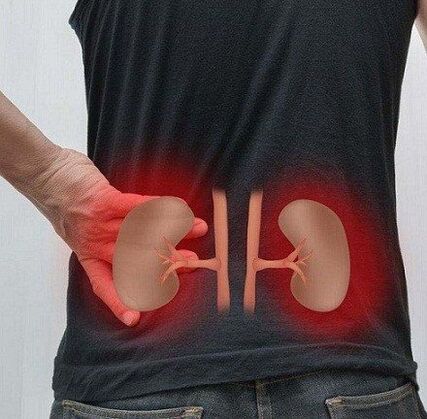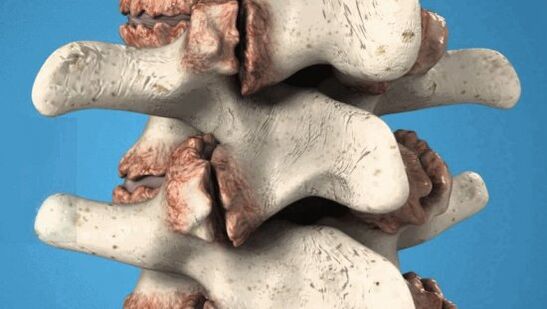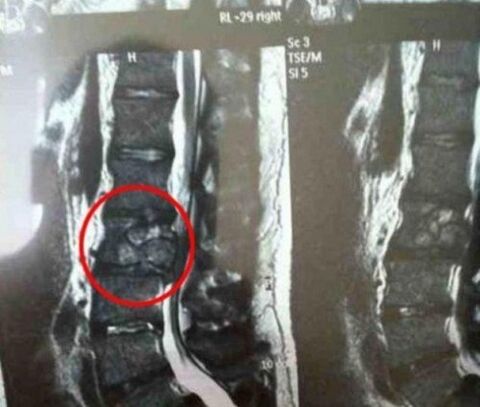
There is virtually no person who would have no back pain in the lower back at least once in his life.In this way, we pay for the uprising and our home habits.
In addition to the damage, which can affect the spine, muscles, nerves and ligaments, it should be borne in mind that sometimes the back in the lower back pain pains with internal diseases - kidney disease, gastrointestinal tract and female genital organs.
Symptoms of lower back pain can range from stupid to acute.The pain can occur independently or go into chronic (the symptom is present for more than three months).
Dangerous!
Take a doctor immediately if:
- Pain in the lumbar region sharply occurred after a clear injury to the back;
- The temperature rises sharply, there are autonomous disorders, loss of consciousness, sweating, difficulty in breathing;
- There is an involuntary emptying of the intestine and bladder;
- Tingling is felt in the groin;
- There was weakness of the lower limbs, their paresis or paralysis, impaired sensitivity;
- The pain is applied to the stomach and sharply increased with cough or sneezing;
- Symptoms occur against the background of abrupt weight loss, long -term use of steroids, immunodeficiency;
- In family history, there were cases of cancer, inflammatory or degenerative diseases of bone cherry tissue.
Why does the back hurt in the lower back?
Myofascial pain
Muscle stretching or spasm can develop gradually or occur suddenly.With high load, damage is affected not only by muscle fibers, but also by ligamentum and fascia.
Then a muscle pain lining appear:
- increasing heavy weights or excessive loading during work or sports;
- Sports from time to time.The muscles are particularly vulnerable if you are inactive during the work week and then spend the watch watch over the weekend;
- a sharp increase in the weight of their own body, behind which the muscles do not have time to grow;
- long sitting or uncomfortable standing;
- carrying a bag daily in one of the hands or above the shoulder;
- Bridge disorders.The spine best performs its maintenance and protective function when you do not bend over.The muscles in the lower back experience the smallest load when you sit with good support under the lower back, and in the position there is evenly distributing the weight of both legs.
If the back is ill after bruising, fracture, stretching, hypothermia, infectious disease or installed helminth invasion, then myositis (inflammation) of the lower back muscles may be suspected.Severe pain is constantly present due to inflammation of the muscle fibers, "nodes" are felt in the muscles spasm.Inflammation can be acute or take chronic form.With a long course of the disease, the pain is unstable, increased with prolonged lying or sitting, closer to the evening or for a change of time.Touching the muscles causes a feeling of pain and discomfort, the muscles of the lower back are in constant tension, forming swelling, the temperature rises locally and at the level of the whole body.
In the case of muscle spasm, the roots of the spinal nerves are impaired, so that the attacks often resemble a picture of Ishii or radiculitis - burning severe pain on the back of the thigh and lower legs are noted, the limbs are tingling and losing sensitivity.The expressed muscle tone for myositis causes the patient to take a forced position, he walks and lies twisted, moves half -legs.
How to treat muscle pain from the spine?Non -steroidal anti -inflammatory drugs and analgesics are used to eliminate inflammation and pain.Medicines can be taken in the form of tablets, ointments, injections, transdermal plasters with a gradual release of active substances.Irritable and warming ointments are also used, which reflexively increases blood flow to the muscles of the lower back.A greater volume of flowing blood helps to extract products from inflammation and tissue breakdown.
Injections of corticosteroids and vasodoning drugs contribute to reducing inflammatory edema.
If the cause of myositis is infection or poisoning of the body with worm toxins, then therapy with antibiotics or antelmintic agents is initially conducted.In this case, it is impossible to use warming ointments or compresses.
Law disease involving nerve endings
In the lumbar section, the vertebrae are separated by elastic cartilage discs that protect the ridge from injuries, but they themselves are subject to wear and aging.
Usually the disc is a pulpic nucleus, similar to jelly, surrounded by a more striped layer of fibrous ring.The elasticity of the nucleus is due to its ability to connect and retain water: when the load increases, it accumulates water and the elasticity increases when the pressure decreases, the nucleus gives water and becomes greater.
Osteochondrosis in the spinal unit develops in case of disruption of food discs (their "drying") or with excessive local loading.Most often, the lower back pain is due to the fact that the lower poles of his intervertebral discs carry the largest load during the seat when they lift the weights in front of them.At the same time, tears, shifts are formed in the discs, the spinal ties are damaged, constant pain and pulsation occur.
Spinal pain has several mechanisms for development:
- Disruption of microcirculation in the tissues around the spine and in particular in the cerebrospinal canal, congestion and edema.Such conditions develop against the background of hypothermia, overheating, inflammatory processes.
- Degenerative processes in the fixing connections of the spine.Increasing the mobility of the vertebrae leads to their easy displacement, not to physiological compression, which causes disturbance of the nerves, blood vessels and the formation of hernia.
- The axial compression of the vertebrae when lifting weights or their damage with excessive rotation (rotation).
- Aseptic inflammation.The destruction of the nucleus leads to the output in the cerebrospinal canal of sensitizing factors.There is irritation of the nerve endings, which causes muscle spasm that disrupt the adjacent vertebrae - higher and under the hernia.Gradually, the reaction covers the entire lumbar and leads to the fact that any movement causes a feeling of pain.
The weakened disc can be torn with the formation of convexity, convexity or prolapse of the nucleus and, as a result, hernia.The appearance of hernia puts pressure on the spinal cord and the roots of the spinal nerves.Under such conditions, the pulsating pain in the lower back occurs sharply, which differs in the abnormal nerve.The most famous cases of compression of the sciatic nerve (needles) manifest with acute pain on the posterior surface of the thigh and lower leg, numbness of the limb from the side of the hernia, muscle weakness, and the involuntary legs unfold.
The pain in the lumbar spine is exacerbated in a sitting position and standing, with turns, inclinations.There is often a protective muscle reaction - a painful muscle contraction (rollers) on both sides of the spine, which isolates the department from excess movement.Subsequently, osteochondrosis leads to the appearance of lumbosacral radiculitis (inflammation of the roots of the spinal nerves).
Spinal syndrome is dangerous with the disruption of the lower back nerves responsible for the innervation of the internal organs (roots of the ponytail).At the same time, the pain is applied to the stomach, the function of the bladder and the intestine is impaired, there are problems with potency in men and gynecological diseases in women.
Many patients, due to the fact that the lower back hurts a lot, take the analgesics that exposes the body to the left if the right side hurts;It lies on the right if the hernia is on the left.The appearance of severe pain when pressed on hernia at the intervertebral interval (symptom of call) is also characteristic.
Than to cure if the back hurts with osteochondrosis:
- During the attack of pain, you can take anesthesia - lie on your back and place the roll under your knees.It is also recommended to sleep on a solid surface;
- From analgesic medicines you can take NSAIDs inward or in the form of injections on both sides of the spine in the lumbar hotel;
- Use local agents as distraction therapy - mustard plasters, iodine nets, peppers and ointments;
- Eliminate mythical spasm through manual therapy, acupuncture, vacuum massage, reflexology, gymnastics;
- When you fade the acute period, you can use mud treatment, ozoc, warming.
The treatment of pain with radicular syndrome includes:
- Provision of bed regime, adhesion of the lumbar region (dry or underwater);
- the use of analgesic blockade at the point of violation, adoption of NSAIDs or weak opiates;
- Physiotherapy - stimulation of micro -prors, electrophoresis with analgesics.
Indications for the surgery are constant acute pain, as well as impaired function of the internal organs, the development of limb paralysis, sequestion of hernia in the spinal canal.
Degenerative lifting lesions
Spondylartrosis (inflammation of the arcuate joints of the vertebrae) occurs during degeneration, reduction of height and volume of intervertebral discs.The lower back pain occurs from the surge of the capsule and increase the pressure on the surface of the intervertebral joints.The pain causes the patient to bend more in the lower back, thus increasing the overload of the intervertebral joints.Especially discomfort in the lower back is enhanced by wearing shoes in heels, long walking, lowering the slopes, the position when the body steps back, for example, when it is considering something over the head.
In patients with such a diagnosis in the morning, stiffness in the lower back is noted, the pain increases during the day or after loading.It has a spilled character and it is difficult to clearly show boundaries: discomfort is determined in the gluteal muscles, the inguinal region, the lower abdomen, in the scrotum in men.This spondylartrosis differs from radicular syndrome when you can specify a source of pain.
What to do to relieve pain?Usually, taking the situation on the back helps bending the legs in the joints of the thighs and knee.
Medicines prefers non -groid anti -inflammatory drugs and non -macotic analgesics.With acute back pain, intramuscular administration of NSAIDs has an intramuscular effect.

Musodias are also added as they relieve muscle tension and improve the mobility of the spine.
Psychotherapy has a positive effect as chronic pain introduces the patient into a state of depression.
Spondylosis, unlike osteochondrosis, affects the fibrous ring of the intervertebral disc and the front longitudinal ligaments.This disease uses composite structures with the formation of the edge of the vertebrae of the outgrowths - osteophytes.These entities cause impaired microcirculation near the roots of the nerves and lead to the fact that the back in the lower back hurts and the mobility of this department is limited.
Treatment is usually conservative using anti -inflammatory drugs, analgesics, vitamins.The good effect has electrophoresis, manual therapy, physiotherapy (amphulles, laser installation, shock wave therapy to destroy seal elements and increase the mobility of the spine).
Pay attention!
At an advanced stage, osteophytes are not absorbed.While their size is small, treatment is aimed at eliminating inflammation, pain, improving metabolism.If the back doesn't hurt much, then nothing is done with outgrowths.If osteophytes cause constant pain or have a large size, then they can be removed during surgery.
Diseases of the tumor nature

Low pain can occur from compression of the spinal cord with a tumor outside (extramedular formations) and inside (an intramedular originating from the spinal substance itself).
The cells of different tissues can grow pathologically:
- Fat - lipoma is formed;
- nerve roots - neurioma;
- Spinal vessels - hemangioma;
- Auxiliary tissue - glioma;
- Bone tissue - osteosarcoma;
- Cartilage matter - chondrosarcoma.
The process of tumor, especially malignant, is characterized by pain that resembles radiculitis (there may be single and bilateral in nature), general deterioration in the patient's condition, exhaustion.
If the pathology affects the lumbar vertebrae I - IV, then the burning pain is felt in the front and the side of the upper thigh, incomplete paralysis of this area.
In the case of damage in the area of IV lumbar segments, numbness of the paragenic area, impaired motor and sensitive innervation of the gluteal muscles, the back of the thigh, calf and incontinence of the stool and urine.
During the neoplasm in the area of V - III, the sacral vertebrae occurs a pronounced violation in the work of the pelvic organs in the area of V - III.The patient suffers from sexual impotence or menstrual disorder, constipation or incontinence of stool and urine.
The treatment of tumors is specific, painkillers and antitumor drugs are a recipe.
As you can see, pain in the lower back is usually caused by musculoskeletal pathologies.They can be diagnosed by clinical signs and examination data, the main task of which is to correctly determine the nature of the disease and not confuse it with cancer, diseases of the internal organs or injury.If the pain in the lower back occurs, we always recommend looking for a neuropathologist or orthopedist for advice.

























